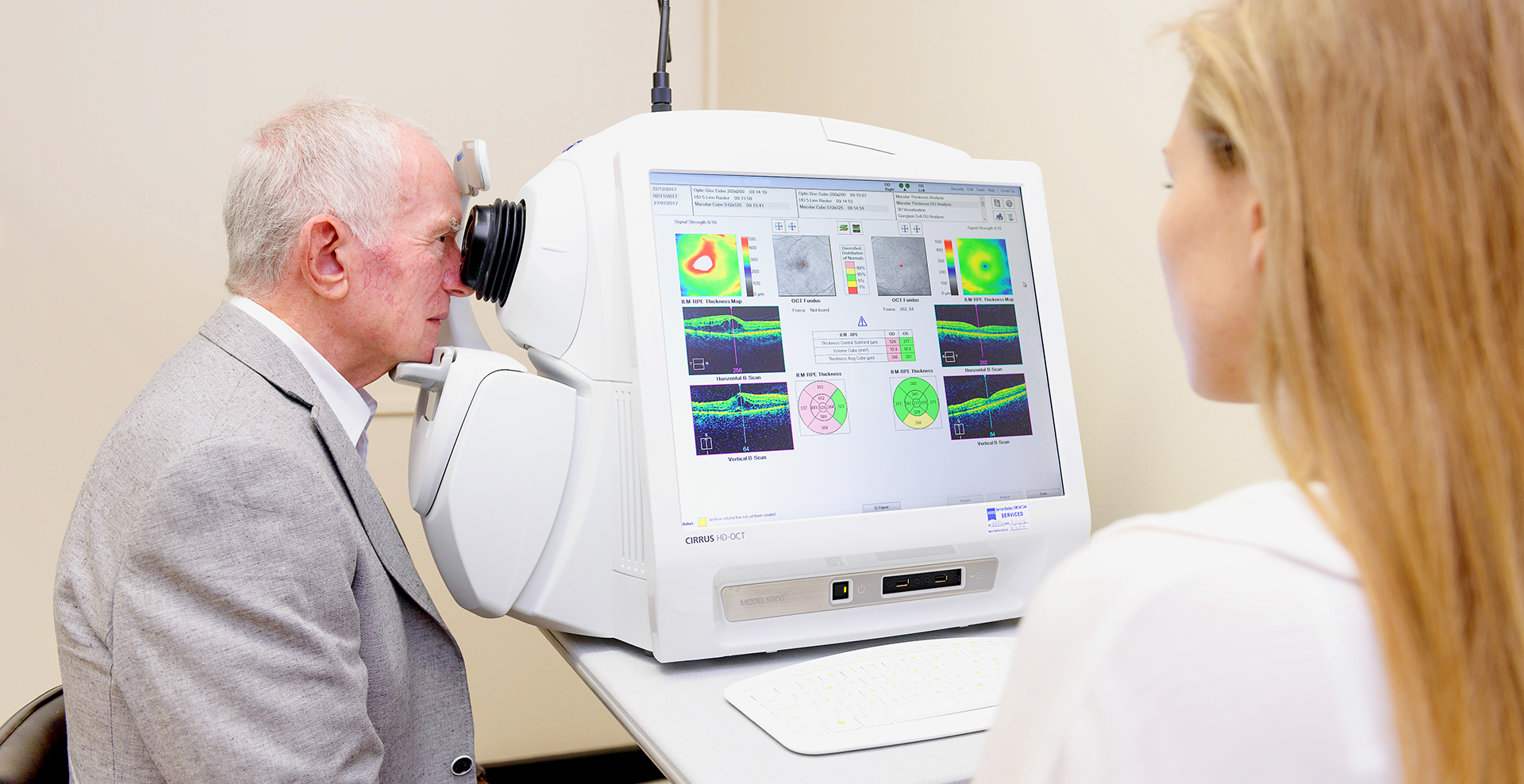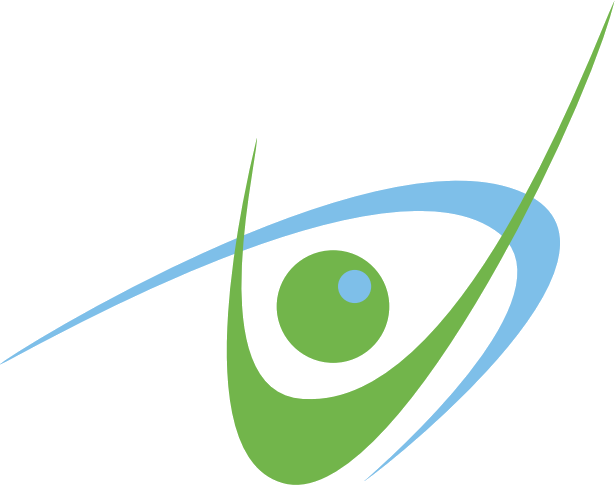Eye Specialist Practice Services
Dr Gregory-Roberts and our doctors provide the following services:
- Assessments of vision and eye health.
- Diagnosis of eye disease including
Age Related Macular Degeneration
Age related macular degeneration (ARMD or AMD) is one of the leading causes of severe visual impairment for individuals over the age of 40 in Australia. The macula is an area in the retina that provides a person’s central vision. This is important for any detailed tasks such as reading, writing and also affects colour vision. Macular degeneration is associated with deposits of fatty substances known as drusen within the retinal layers. There are two types of AMD, dry and wet. Dry AMD is the most common and usually causes a gradual deterioration of central vision. Wet AMD causes sudden and significant visual loss. Wet AMD is caused by a leakage of fluid underneath the retinal layers.
Common symptoms:
- Gradual loss of clarity in vision
- Distortion of straight lines
- Dark or empty spaces covering central vision
- Dimming of colour vision
Risk factors for AMD:
- Older age
- Family history of AMD
- Increased sun exposure
- Smoking
Treatment
Currently there is no treatment available for dry AMD. However there are treatments available for wet AMD. Wet AMD is usually treated with an injection into the eye. Any invasive procedure carries risks which need to be taken into account before deciding whether to proceed with treatment.
In some cases, severe vision loss can be prevented as certain forms of the AMD respond well to treatment, especially with early diagnosis and timely intervention. For many patients, certain preventative measures can be employed which may help to slow the progression of AMD.
Cataracts
Cataracts are very common. Worldwide, cataracts are the number one cause of preventable blindness. The majority of cataracts are associated with increasing age. Cataracts causes a cloudy appearance to the lens in the eye. Cataracts can occur in younger people but it significantly less common.
Common Symptoms:
- Gradual blur and dimming of vision
- glare and halos around lights
- poor vision at night
- difficulty reading in dim light
- Occasionally can cause double vision
- Increase in short sightedness (myopia) / changes in glasses or contact lens prescription.
Risk factors associated with cataracts developing:
- Increasing age
- Ultraviolet exposure
- Prior eye surgery
- Smoking
- Previous eye trauma
People can also get cataracts earlier from certain conditions. These include:
- Diabetes
- Steroid treatment
- Recurrent uveitis (inflammation inside the eye)
Treatment:
Surgery is the only treatment for cataracts. Surgery can be recommended based on the severity of the cataract and the individual’s visual needs. All surgery carries risks and the risks need to be taken into account before deciding to proceed with surgery. Cataract surgery involves the removal of the cloudy lens in the eye (cataract) and implanting a new and clear synthetic intraocular lens (IOL).
You will need an assessment by the ophthalmologist in order to decide whether cataract surgery is the correct treatment for you. The procedure is performed in a day surgery. If both eyes need surgery, one eye will be done initially and usually the second eye surgery is done several weeks afterwards. The surgery lasts approximately twenty minutes.
Diabetic Retinopathy
Diabetic patients can develop a condition called diabetic retinopathy (DR). In a diabetic patient the smaller blood vessels in the back of the eye can easily leak. Sometimes abnormal blood vessels grow in the eye. Diabetic retinopathy can affect peripheral vision as well as central vision. It can cause blind spots in the vision depending on the areas damaged.
Common Symptoms:
- Blurred or distorted vision
- Blind spots in vision
Risk factors for developing DR:
- A long history of diabetes
- Poorly controlled or high blood sugar levels
- High blood pressure
Treatment:
Prevention of sight-threating retinopathy is the aim. Screening and monitoring of DR is essential. All diabetics should undergo a dilated fundus examination (examining the retina) at least once per year. Some DR can be treated with injections in the eye, or laser. Any invasive procedure carries risks which need to be taken into account before deciding whether to proceed with the treatment. This will depend on the severity and location of the retinopathy.
Dry Eye
Dry eye is a very common condition that can vary from mild to severely irritating. Dry eye is caused by a deficiency in the tear film. The tear film is important as it not only provides protection for the cornea but also it helps the quality of vision.
Common Symptoms:
- Burning or stinging sensation
- Eyes watering
- Sandy or gritty feeling
- Scratchy or foreign-body sensation
- Discharge
- Frequent blinking
- Caking of the eyelashes (usually worse upon waking)
- Redness
- Blurry or fluctuating vision (can be made worse when reading, computer, watching television or driving)
- Sensitivity to light
Risk Factors for developing Dry Eye:
- Eyelid conditions (Blepharitis or Meibomian gland dysfunction)
- Insufficient tear production common in people over 50 or postmenopausal woman
- Certain medications such as antihistamines, hormone replacement therapy and anti-depressants
- Certain medical conditions such as: Sjogren’s syndrome, thyroid disorders, diabetes and rheumatoid arthritis
- Previous injuries to the eyes
- Previous eye surgery
- Infrequent blinking
- Environmental (dusty, windy, hot or dry)
- Contact lens use
- Neurologic conditions, including stroke, Bell’s palsy or Parkinson’s Disease
- Exposure keratitis, which can occur when the eyelids do not close completely during sleep
- Following refractive surgery (LASIK or PRK)
Treatment:
Dry eye treatment will depend on the cause of the condition. Once the Ophthalmologist has diagnosed the condition and cause, the patient can be put on a treatment plan.
This can include:
- Hot compresses and lid massages
- Lid Hygiene
- Lubricating Drops and/or ointment
- Punctal Plugs
- IPL – Intense pulsed light
Glaucoma
Glaucoma is a group of eye diseases that cause a loss of vision due to optic nerve damage. Generally in the early stages of this condition there are no symptoms. The loss of sight is usually gradual and a considerable amount of peripheral vision may be lost before there is an awareness of any problem. The intraocular pressure (IOP) is the fluid pressure in the eye. In patients with glaucoma, eye pressures need to be reduced to slow down the progression of optic nerve damage. Depending on the type of glaucoma, some people will have normal intraocular pressure while others have higher pressures. Some normal individuals can have high intraocular pressure and never get glaucoma. The best way to check if you are at risk or have glaucoma is to have the eyes examined. Glaucoma cannot be self -detected and many people may not be aware of any vision loss.
Risk factors for Glaucoma:
- Myopia (short-sightedness)
- Increasing age
- Family history of Glaucoma- more common in first-degree relatives
- Diabeties
- Thin corneas
There is another type of Glaucoma that can sometimes present with symptoms. This is called Angle Closure Glaucoma. This happens when the fluid (aqueous humour) in the eye cannot drain properly due to a physical narrowing of the fluid outflow pathways.
Symptoms include:
- Painful eye
- Sensitivity to light
- Seeing halos in vision
- Nausea
- Vomiting
Treatment:
There is no cure for Glaucoma however early detection and adherence to treatment can halt or significantly slow progression. Generally, damage to the optic nerve cannot be reversed. Treatment can include taking drops daily. In certain cases, laser or surgery is performed to prevent further damage to the optic nerve. Any surgical or invasive procedure carries risks which need to be taken into account before deciding whether to proceed with treatment.
New technology has recently been developed to improve the control of intra-ocular pressures such as the iStent™, Cypass™ and Xen™ implant. These are minimally invasive glaucoma surgical procedures to improve the drainage of fluid from the eye. After these procedures, it may mean that an individual with glaucoma will need fewer medications (eye drops) to control their eye pressure.
- Treatment of eye conditions using medications, surgery and laser.


